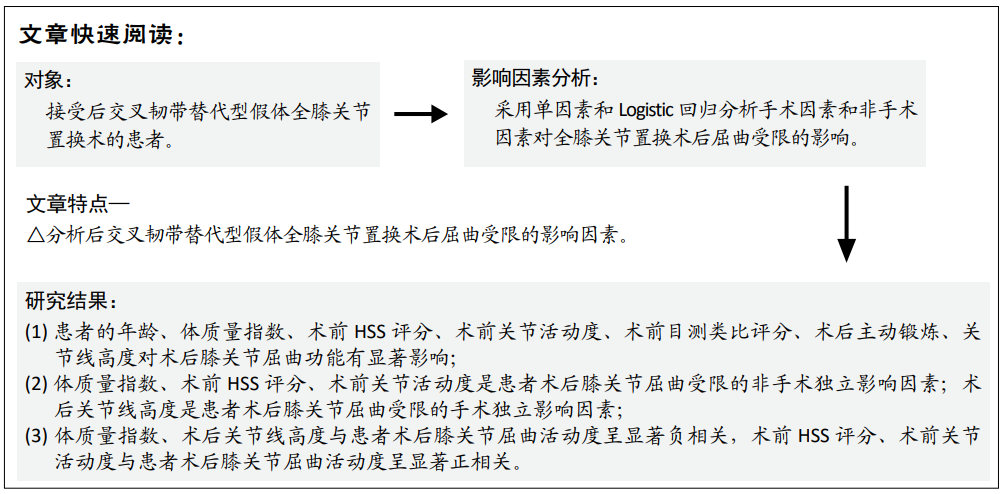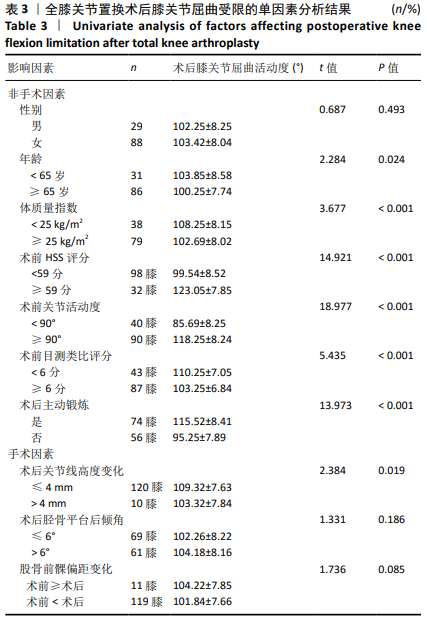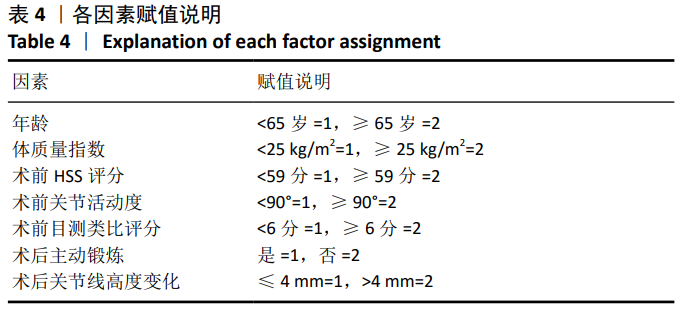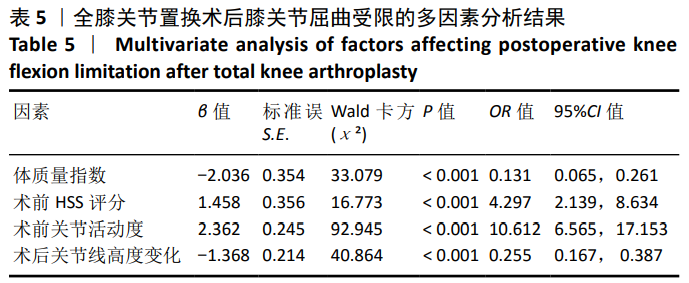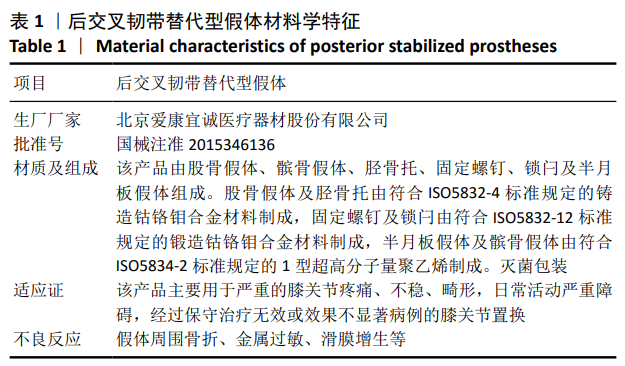[1] 中华医学会骨科学分会关节外科学组.骨关节炎诊疗指南(2018年版)[J].中华骨科杂志,2018,38(12):705-715.
[2] NOBLE PC, CONDITT MA, COOK KF, et al. The John Insall Award: Patient expectations affect satisfaction with total knee arthroplasty. Clin Orthop Relat Res. 2006;452:35-43.
[3] BOURNE RB, CHESWORTH BM, DAVIS AM, et al. Patient satisfaction after total knee arthroplasty: who is satisfied and who is not? Clin Orthop Relat Res. 2010;468(1):57-63.
[4] HA CW, PARK YB, SONG YS, et al. Increased Range of Motion Is Important for Functional Outcome and Satisfaction After Total Knee Arthroplasty in Asian Patients. J Arthroplasty. 2016;31(6):1199-1203.
[5] HOFMANN AA, KURTIN SM, LYONS S, et al.Clinical and radiographic analysis of accurate restoration of the joint line in revision total knee arthroplasty.J Arthroplasty.2006;21(8):1154-1162.
[6] SCOTT CEH, CLEMENT ND, YAPP LZ, et al. Association Between Femoral Component Sagittal Positioning and Anterior Knee Pain in Total Knee Arthroplasty. J Bone Joint Surg. 2019;101(17):1575-1585.
[7] NG N, PATTON J T, BURNETT R, et al. Sagittal alignment of the cemented femoral component in revision total knee arthroplasty influences the anterior and posterior condylar offset: Stem length does not affect these variables. Knee. 2020;27(2):477-484.
[8] CHIU KY, NG TP, TANG WM, et al. Review Article: Knee Flexion after Total Knee Arthroplasty. J Orthop Surg (Hong Kong). 2002;10(2): 194-202.
[9] ARGENSON JN, BOISGARD S, PARRATTE S, et al. French Society of Orthopedic and Traumatologic Surgery (SOFCOT). Survival analysis of total knee arthroplasty at a minimum 10 years’ follow-up: a multicenter French nationwide study including 846 cases. Orthop Traumatol Surg Res. 2013;99(4):385-390.
[10] CAROTHERS JT, KIM RH, DENNIS DA, et al. Mobile-bearing total knee arthroplasty: a meta-analysis. J Arthroplasty. 2011;26(4):537-542.
[11] PARSCH D, KRÜGER M, MOSER MT, et al. Follow-up of 11-16 years after modular fixed-bearing TKA. Int Orthop. 2009;33(2):431-435.
[12] VAN ONSEM S, VERSTRAETE M, DHONT S, et al. Improved walking distance and range of motion predict patient satisfaction after TKA. Knee Surg Sports Traumatol Arthrosc. 2018;26(11):3272-3279.
[13] DEVERS BN, CONDITT MA, JAMIESON ML, et al. Does greater knee flexion increase patient function and satisfaction after total knee arthroplasty? J Arthroplasty. 2011;26(2):178-186.
[14] SINGH JA, O’BYRNE M, HARMSEN S, et al. Predictors of moderate-severe functional limitation after primary Total Knee Arthroplasty (TKA): 4701 TKAs at 2-years and 2935 TKAs at 5-years. Osteoarthritis Cartilage. 2010;18(4):515-521.
[15] XU S, CHEN JY, LO NN, et al. The influence of obesity on functional outcome and quality of life after total knee arthroplasty: a ten-year follow-up study. Bone Joint J. 2018;100-B(5):579-583.
[16] LANGE JK, LEE YY, SPIRO SK, et al. Satisfaction Rates and Quality of Life Changes Following Total Knee Arthroplasty in Age-Differentiated Cohorts. J Arthroplasty. 2018;33(5):1373-1378.
[17] MERLE-VINCENT F, COURIS CM, SCHOTT AM, et al. Osteoarthritis Section of the French Society for Rheumatology. Factors predicting patient satisfaction 2 years after total knee arthroplasty for osteoarthritis. Joint Bone Spine. 2011;78(4):383-386.
[18] PUA YH, POON CL, SEAH FJ, et al. Predicting individual knee range of motion, knee pain, and walking limitation outcomes following total knee arthroplasty. Acta Orthop. 2019;90(2):179-186.
[19] LANGLOIS J, CHARLES-NELSON A, KATSAHIAN S, et al. Predictors of flexion using the rotating concave-convex total knee arthroplasty: preoperative range of motion is not the only determinant. Knee Surg Sports Traumatol Arthrosc. 2015;23(6):1734-1740.
[20] 张恒岩,崔立强,翁习生.影响全膝关节置换术疗效的术前因素分析[J].中华医学杂志,2016,17(96):1345-1348.
[21] RUSSELL RD, HUO MH, DE JONG L, et al. Preoperative flexion does not influence postoperative flexion after rotating-platform total knee arthroplasty. Knee Surg Sports Traumatol Arthrosc. 2014;22(7): 1644-1648.
[22] 张银光,王岩,柴伟.应用多元回归分析影响全膝关节置换术后膝关节活动度的相关因素[J].中国组织工程研究与临床康复,2007, 11(47):9462-9465.
[23] BAWA HS, WERA GD, KRAAY MJ, et al. Predictors of range of motion in patients undergoing manipulation after TKA. Clin Orthop Relat Res. 2013;471(1):258-263.
[24] WITVROUW E, BELLEMANS J, VICTOR J. Manipulation under anaesthesia versus low stretch device in poor range of motion after TKA. Knee Surg Sports Traumatol Arthrosc. 2013;21(12):2751-2758.
[25] VAN LIESHOUT WAM, VALKERING KP, KOENRAADT KLM, et al. The negative effect of joint line elevation after total knee arthroplasty on outcome. Knee Surg Sports Traumatol Arthrosc. 2019;27(5):1477-1486.
[26] HAN HS, YU CH, SHIN N, et al. Femoral joint line restoration is a major determinant of postoperative range of motion in revision total knee arthroplasty. Knee Surg Sports Traumatol Arthrosc. 2019;27(7): 2090-2095.
[27] FORNALSKI S, MCGARRY MH, BUI CN, et al. Biomechanical effects of joint line elevation in total knee arthroplasty. Clin Biomech (Bristol, Avon). 2012;27(8):824-829.
[28] CINOTTI G, SESSA P, RAGUSA G, et al. Influence of cartilage and menisci on the sagittal slope of the tibial plateaus. Clin Anat. 2013;26(7): 883-892.
[29] 刘凯,沈彬,裴福兴,等. Innex膝关节假体置换术后活动度与假体设计及手术技术的关系[J].中华骨科杂志,2011,31(2):137-142.
[30] MIHALKO W, FISHKIN Z, KRAKOW K. Patellofemoral Overstuff and Its Relationship to Flexion after Total Knee Arthroplasty. Clin Orthop Relat Res. 2006;449: 283-287.
[31] KEMP MA, METCALFE AJ, SAYERS A, et al. Does overstuffing of the patellofemoral joint in total knee arthroplasty have a significant effect on postoperative outcomes? Knee. 2018;25(5): 874-881. |
